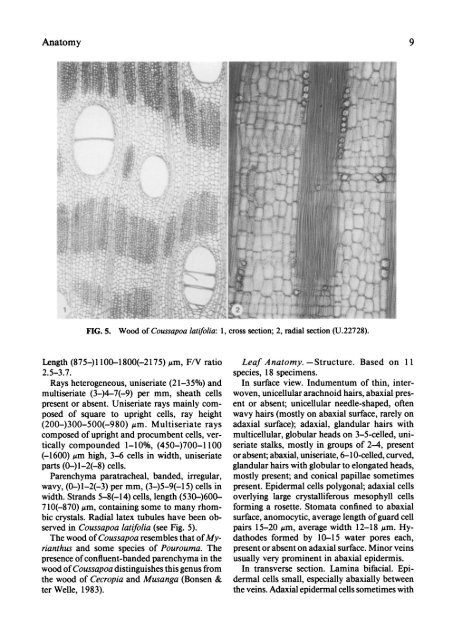Cecropiaceae: Coussapoa and Pourouma, with an ... - CNCFlora
Cecropiaceae: Coussapoa and Pourouma, with an ... - CNCFlora
Cecropiaceae: Coussapoa and Pourouma, with an ... - CNCFlora
You also want an ePaper? Increase the reach of your titles
YUMPU automatically turns print PDFs into web optimized ePapers that Google loves.
Anatomy<br />
, ,. : ?<br />
? ~ ~ ~ i<br />
I i ~ ~.: II~C ... ?<br />
~~~~:':-<br />
%,-: :<br />
;~ ~ ~<br />
' '" 2.'' ? .. ' , ' ? "'."' ..<br />
:i...<br />
t<br />
. ...-I. : .,<br />
:.<br />
' '<br />
%;.: ,,<br />
I,~~~~~.<br />
F?<br />
I<br />
'<br />
- i. " ' ~, c .?.h<br />
1;<br />
? t*l..:.<br />
.::.:.;.<br />
... ~ ,,~x ~ ~ .....~<br />
. "~~~-i<br />
FiG. 5. Woo of Co p~ltf'l9 , ,cos ci~ ~ lsci~(.22<br />
Length (875-)1100-1800(-2175) .m, F/V ratio<br />
2.5-3.7.<br />
Rays heterogeneous, uniseriate (21-35%) <strong><strong>an</strong>d</strong><br />
multiseriate (3-)4-7(-9) per mm, sheath cells<br />
present or absent. Uniseriate rays mainly composed<br />
of square to upright cells, ray height<br />
(200-)300-500(-980) gtm. Multiseriate rays<br />
composed of upright <strong><strong>an</strong>d</strong> procumbent cells, vertically<br />
compounded 1-10%, (450-)700-1100<br />
(-1600) ,m high, 3-6 cells in width, uniseriate<br />
parts (0-)1-2(-8) cells.<br />
Parenchyma paratracheal, b<strong><strong>an</strong>d</strong>ed, irregular,<br />
wavy, (0-)1-2(-3) per mm, (3-)5-9(-15) cells in<br />
width. Str<strong><strong>an</strong>d</strong>s 5-8(-14) cells, length (530-)600-<br />
710(-870) Mm, containing some to m<strong>an</strong>y rhombic<br />
crystals. Radial latex tubules have been observed<br />
in <strong>Coussapoa</strong> latifolia (see Fig. 5).<br />
The wood of <strong>Coussapoa</strong> resembles that of Myri<strong>an</strong>thus<br />
<strong><strong>an</strong>d</strong> some species of <strong>Pourouma</strong>. The<br />
presence of confluent-b<strong><strong>an</strong>d</strong>ed parenchyma in the<br />
wood of <strong>Coussapoa</strong> distinguishes this genus from<br />
the wood of Cecropia <strong><strong>an</strong>d</strong> Mus<strong>an</strong>ga (Bonsen &<br />
ter Welle, 1983).<br />
'<br />
. . . .<br />
Leaf Anatomy. -Structure. Based on 11<br />
species, 18 specimens.<br />
In surface view. Indumentum of thin, inter-<br />
woven, unicellular arachnoid hairs, abaxial pres-<br />
ent or absent; unicellular needle-shaped, often<br />
wavy hairs (mostly on abaxial surface, rarely on<br />
adaxial surface); adaxial, gl<strong><strong>an</strong>d</strong>ular hairs <strong>with</strong><br />
multicellular, globular heads on 3-5-celled, uni-<br />
seriate stalks, mostly in groups of 2-4, present<br />
or absent; abaxial, uniseriate, 6-10-celled, curved,<br />
gl<strong><strong>an</strong>d</strong>ular hairs <strong>with</strong> globular to elongated heads,<br />
mostly present; <strong><strong>an</strong>d</strong> conical papillae sometimes<br />
present. Epidermal cells polygonal; adaxial cells<br />
overlying large crystalliferous mesophyll cells<br />
forming a rosette. Stomata confined to abaxial<br />
surface, <strong>an</strong>omocytic, average length of guard cell<br />
pairs 15-20 gm, average width 12-18 um. Hy-<br />
dathodes formed by 10-15 water pores each,<br />
present or absent on adaxial surface. Minor veins<br />
usually very prominent in abaxial epidermis.<br />
In tr<strong>an</strong>sverse section. Lamina bifacial. Epi-<br />
dermal cells small, especially abaxially between<br />
the veins. Adaxial epidermal cells sometimes <strong>with</strong>
















